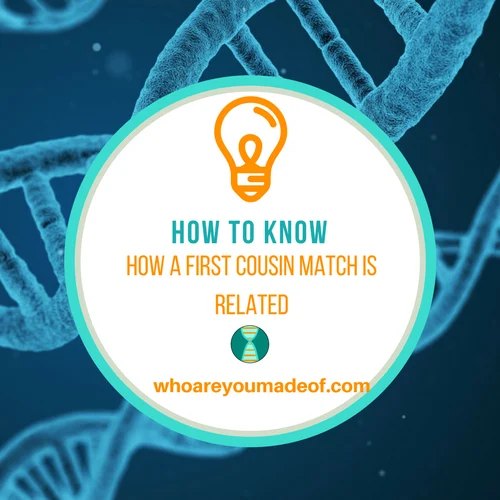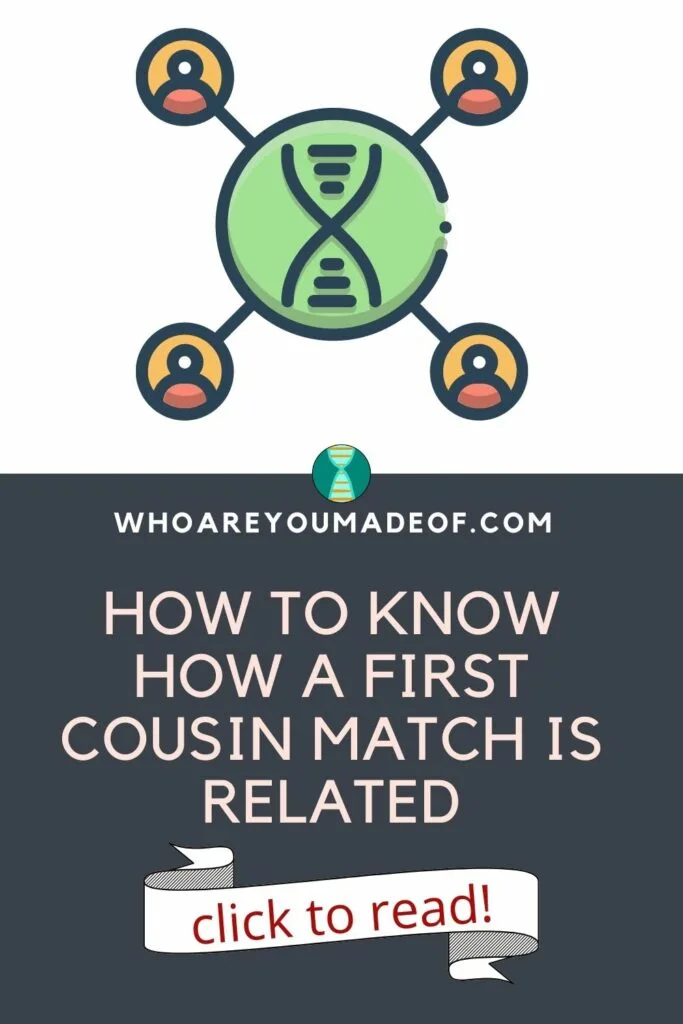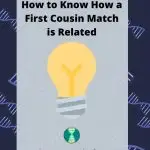How is your first cousin DNA match related to you? If you have a relative on your DNA match list that shows up as a first cousin, learn how they might be related to you in this article.
Whether you tested with Ancestry DNA, Family Tree DNA, MyHeritage, or 23andMe, you will find the answers that you need below.

It's exciting to have a new close relative, but it can also be confusing to try to imagine how your first cousin match might fit into your family tree. It is understandable that it is important to you to work out your connection to your newly discovered relative.
Below, I will explain a few ways that might help you know how a first cousin DNA match is related to you, as well as some other important aspects of understanding your DNA matches.
Are they really a first cousin?
If your DNA testing company has categorized your new match as a "first cousin", you should know that this is just an estimate. There is no way that the testing company can report to you with 100% certainty that your new first cousin match is a true first cousin to you.
Even so, you can be 100% sure that your first cousin DNA match is closely related to you. It will take some old-fashioned detective work in order to figure out exactly who they are.
When Ancestry DNA, or other DNA testing company, tells you that someone is a first cousin, for example, they are using the amount of shared DNA to make an estimate. This shared DNA is reported to you as "shared centimorgans".
(Click here to learn how to access shared centimorgans on Ancestry.)
There are several relationships that fall into the same range of shared centimorgans (cMs) that we see for first cousins, which is 575-1330 cMs. Expressed as a percentage, we expect first cousins to share between about 7.5-18% of their DNA.
People who fall between about 575-1330 centimorgans of shared DNA certainly could be first cousins. However, there are many other relationship distances that they could be to you.
This means that someone who falls into the first cousin category could be a:
- First cousin
- Half aunt
- Half uncle
- Half neice
- Half nephew
- Great-grandparent or great-grandchild
- Great-uncle or great-aunt
- Grand-niece or grand-nephew
With all of these relationship types that it could possibly be, are you just more confused? Don't worry, there are some ways to narrow down the possibilities.
Using shared centimorgans to know your relationship to a first cousin DNA match
As I mentioned before, there are typical ranges for shared DNA between different types of familial relationships. In order to know which range your first cousin match fits into, you will need to know the exact amount of shared DNA, in centimorgans.
All of the major DNA testing companies report the total number of centimorgans. The only exception is 23andMe when the customer has not opted for this information to be displayed about them to their matches..
Once you know the number of centimorgans you share, you can consult the list below to see which relationship type "fits" your particular DNA match:
- First cousin (Average: 874 Low: 553 High: 1225 )
- Half aunt, half uncle, half niece, half nephew (Average: 891 Low: 500 High: 1446 )
- Great-grandparent or great-grandchild (Average: 881 Low: 464 High: 1486)
- Great-uncle or great-aunt (Average: 915 Low: 251 High: 2108)
- Grand-niece or grand-nephew (Average: 910 Low: 251 High: 2108 )
You might be able to eliminate some of the relationship possibilities based on the amount of shared DNA. Once you've done this, move on to the next steps.
Who you do you share in common with your first cousin DNA match?
Once you find out how much DNA you share with someone, you might be able to find out which side of your family that they are on by checking to see which matches you share in common with them.
If you have a parent, half-sibling, grandparent, first cousin, or second cousin match on your DNA match list, then by either sharing your mystery match in common, or not sharing the match in common, with a particular person can help you figure out which line of the family they are most likely on.
You can find this information easily on Ancestry DNA using the "Shared Matches" tab on the match profile, or on Family Tree DNA using the "=in common with" search filter on your match list. 23andMe shows which DNA matches you share with a match if you click on the match, scroll to the bottom, and click "Find Relatives in Common".
Once you know the type of relationship that you probably have, and which line of the family they might be on, you are very close to figuring out who they most likely are to you.
See what you can learn from their DNA match profile on your testing company's website
Ancestry DNA is one of my favorite companies for DNA testing, since they also highly encourage family tree research, and many people who have tested have family trees attached to their DNA results. I'll use Ancestry DNA as my example here, but the same ideas should work if you find matches on other testing company sites.
You will want to learn as much as you can about your DNA match. I encourage taking screenshots of information that you do find, just to make sure you don't lose access to it later.
Sometimes, you might stumble across an interesting tidbit of data, and then find that you can't locate it later. Screenshots help you avoid this potential problem.
You are interested in knowing about the parents, grandparents, and great-grandparents of your DNA match. Most likely, your connection is somehow at the level of the grandparents of your match, but there is always a chance that it is as far back as great-grandparents - depending on who they are to you and who you are to them.
Information that is helpful to know about your first cousin DNA match:
- Find out your match's approximate age
- Where your match might have been born
- Locate their surname, or the surname of their parents or grandparents
Here are some examples of how the seemingly insignificant data above can help you determine who the person can possibly be to you:
- If you know that they are 50 years younger than you, and that one of their parents was born in the same town as your nephew, they could be a grand niece or grand nephew.
- If you are in your twenties, and you find an elderly first cousin DNA match, and they were born in the same town as one of your grandparents, you should investigate the idea that they are a great-aunt or great-uncle
Keep in mind, however, that people have always traveled, and that the "typical" range for having children, especially for men, ranges over period of at least a few decades. Just use this information, along with everything else that you learn, to try to help you eliminate or determine a relationship possibility.
Contact your first cousin DNA match
Once you have done all of the other tasks in this post, you can consider contacting your DNA match. I recommend that this be the last thing that you do for several reasons:
- You will have had a chance to learn as much as you can before communicating. This way, you know what you know, and then you can compare this with what your match says (or doesn't say)
- You will have had time for the excitement of a close match to fade a bit, and you can craft a calm, non-emotional note
- You will have had time to take screenshots of information, including family trees and DNA profiles. A first cousin match is a pretty close match, and sometimes people realize that they might have unwittingly uncovered a family secret and delete their DNA results and family trees in order to cover it back up again. Depending on who/what you are looking for in your DNA test journey, losing access to this information could set you back.
If you contact your first cousin match, and you are able to compare "notes" about your family history, using the information that you have learned about them, and about your family tree, you should be able to figure out their exact relationship to you.
If you still can't figure it out...
Have more family members do a DNA test
If you know a lot about your family, and you have family members who are willing to also do a DNA test to help you learn more about family history, you might consider asking them to do so.
If you want them to do a test in order to learn more about a particular match, I would recommend being honest with them about why you would like them to consider taking a DNA test.
Explain that you have a match that you are not familiar with, and that by them doing a test, you will be able to learn which side of the family they are on, and more about their possible relationship to you.
Aunts, uncles, grandparents, great-aunts, and uncles, and even cousins are great people to talk to about DNA testing. Depending on who your unknown first cousin match is to you, they might share even more DNA with an older relative, and this will give you further clues as to where they fit in your family.
If they don't match an aunt or uncle, and you do, then you can feel confident that they are on the different side of your family tree. A final benefit of having older/more family members to this type of test is the ability to learn even more about your family history.

Conclusion
I hope that this post gave you some ideas about how to figure out how your first cousin DNA match is related to you. If you have any questions about anything that I have mentioned, please feel free to leave your comment below.
Thanks for stopping by!



Margie Lewis
Thursday 18th of June 2020
Thank you. That was very informative information. . I've been told all my life by my brothers and sisters that I had a different father. My mother denies it. So I asked My father's brother, Since my father is no longer alive, to take a DNA test. He does not come up in my DNA matches. So I had my brother Take a DNA test. And him and I both have very different matches.
Then the other day I got a brand new Close relative hit. Someone I've never heard of. As a first cousin. However Her name is the same as my great-niece. So I asked my sister how her granddaughter came up as my first cousin. And I sent a screenshot. Then my sister said that isn't my granddaughter.
So now I'm wondering if my mother is lying. So I contacted the person and now I see that maybe I should have waited stead of being so emotional and excited. I ended up telling her the whole story and I hope she contacts me back now.
But I still don't understand how my great-niece. Could come up as a first cousin. It's 752 cm.
But now after reading your post. Excitement's gone away, because I see how it's possible to show up as my first cousin and still be my great niece. So, thank you very informative. But I'm still going to Hope I found my father. Or at least until I hear otherwise.